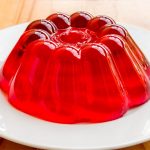 A jellied food made with a mixture of strained fruit(s) (45 parts by weight) and 55 parts by weight of a saccharine ingredient. Spices, acidifying agents, pectin, buffering agents, preservatives and antifoaming agents except those derived from animal sources, and mint flavoring or cinnamon flavoring may be added.
A jellied food made with a mixture of strained fruit(s) (45 parts by weight) and 55 parts by weight of a saccharine ingredient. Spices, acidifying agents, pectin, buffering agents, preservatives and antifoaming agents except those derived from animal sources, and mint flavoring or cinnamon flavoring may be added.
Although they hardly look the same, the word jelly and the word cold derive from the same source, an Indo-European word, pronounced something like ghel, that meant to be cold. This ancient word evolved into the Germanic word kal, which eventually developed into the English words cool, chill, and cold. The same Indo-European source, ghel, also evolved into the Latin words gelu, meaning frost, and gelare, meaning to freeze into a solid. From gelare, Old French acquired gelee, meaning both^rosf and jelly, which English borrowed in the late fourteenth century as gely; the word retained this spelling until the seventeenth century when it came to be spelt jelly. Shortly after, in the early eighteenth century, jelly also shifted in meaning: when it first emerged in English, jelly—or gely—had referred to the semi-solid substance extracted from an animal’s carcass by boiling it and skimming off the slumgullion that rises to the surface; in the early eighteenth century, however, the word jelly started to be used as a name for sweet fruit preserves whose semi-solid consistency resembled animal jelly. Eventually, the word jelly became so identified with this popular fruit preserve that a new word had to be found to refer to the “jelly” extracted from animal carcasses. Accordingly, the French word gelatine, which derives from the same Latin source as jelly, was adopted at the beginning of the nineteenth century as gelatin, which thereafter took over the original sense of jelly.
A colloidal suspension of fruit juice. The suspension is created by the hydration of pectin.
A thick, semisolid, gelatinous mass.
A substance that is solid and possesses a relatively clear appearance, yet has a supple and resilient texture resembling gelatin, is commonly referred to as a jelly. This term often alludes to a mixture of fruit juice and sugar that has been boiled and then solidified with pectin.
The process of creating jelly is akin to that of making jam. However, it is even more crucial to ensure that the fruit employed has a high pectin and acid content. This is because a jelly with a runny consistency is challenging to work with. While most fruits are suitable for jelly-making, a few exceptions exist. Fruits with low acid or pectin levels, such as strawberries and cherries, are unsuitable for this purpose.
